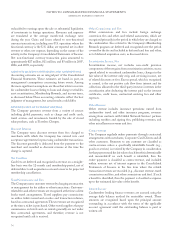American Express 2007 Annual Report Download - page 81
Download and view the complete annual report
Please find page 81 of the 2007 American Express annual report below. You can navigate through the pages in the report by either clicking on the pages listed below, or by using the keyword search tool below to find specific information within the annual report.NOTES TO CONSOLIDATED FINANCIAL STATEMENTS
AMERICAN EXPRESS COMPANY
•Statement of Financial Accounting Standard (SFAS) No.
157, “Fair Value Measurements” (SFAS No. 157), defines
fair value, establishes a framework for measuring fair value
and applies broadly to financial and non-financial assets and
liabilities reported or disclosed at fair value under existing
authoritative accounting pronouncements. SFAS No. 157
also establishes a multi-level hierarchy that prioritizes the
inputs to the valuation techniques used to measure fair value.
In addition, SFAS No. 157 expands disclosure requirements
regarding the methods and inputs used to measure fair value
and the effects on earnings.
On January 1, 2008, the Company adopted SFAS
No. 157 for its financial assets and liabilities only. The
corresponding required disclosures will be included in the
Company’s March 31, 2008, quarterly report on Form 10-Q.
FASB Staff Position FAS 157-2 “Effective Date of FASB
Statement No. 157” permits for the deferred effective date
of SFAS No. 157 for non-financial assets and liabilities until
January 1, 2009. The Company elected this deferral option
for its non-financial assets and liabilities.
•SFAS No. 158, “Employers’ Accounting for Defined Benefit
Pension and Other Postretirement Plans – an amendment
of the FASB Statements No. 87, 88, 106, and 132(R)”
(SFAS No. 158) requires the measurement date for the
benefit obligation and plan assets to be the Company’s fiscal
year end for years ending after December 15, 2008. The
Company currently uses a September 30 measurement date.
In order to facilitate this change, the Company will use the
September 30, 2007 valuation to estimate pension and other
employee benefit plan cost for 2008 and will perform an
additional valuation as of December 31, 2008. The change
in the measurement date will result in a one-time adjustment
to retained earnings and accumulated other comprehensive
income in the fourth quarter of 2008.
• SFAS No. 159, “The Fair Value Option for Financial
Assets and Financial Liabilities-Including an amendment
of FASB Statement No. 115” (SFAS No. 159), provides
companies with an option to report selected financial assets
and liabilities at fair value. SFAS No. 159 allows entities to
irrevocably elect, on a contract by contract basis, fair market
value as the initial and subsequent measurement for certain
financial assets and financial liabilities. The Company does
not plan to elect the option to fair value any financial assets
or financial liabilities under SFAS No. 159.
• Emerging Issues Task Force Issue No. 06-11, “Accounting for
Income Tax Benefits of Dividends on Share-Based Payment
Awards” (EITF 06-11), clarifies when income tax benefits
for dividends paid on employee share-based payment awards
should be recognized in equity or the income statement.
In addition to the above, the FASB has recently issued the
following accounting standards, which are effective beginning
January 1, 2009. The Company is currently evaluating the
impact of these accounting standards.
• SFAS No. 141 (revised 2007), “Business Combinations”
(SFAS No. 141(R)), requires the acquiring entity in a
business combination to (1) recognize all assets acquired
and liabilities assumed generally at their acquisition-date
fair values; (2)record those assets and liabilities at their full
fair value amounts even if there is noncontrolling (minority)
interest; (3) include noncontrolling interest earnings through
net income; (4) expense acquisition-related transaction
costs; and (5) disclose information needed to evaluate and
understand the nature and financial effect of the business
combination. SFAS No. 141(R) is effective for the Company
for any acquisitions occurring in 2009 and years thereafter.
• SFAS No. 160, “Noncontrolling Interests in Consolidated
Financial Statements” (SFAS No. 160), which is to
be retrospectively applied, requires entities to include
noncontrolling (minority) interests in partially owned
consolidated subsidiaries within shareholders’ equity in
the consolidated financial statements. SFAS No. 160 also
requires the consolidating entity to include the earnings of
the consolidated subsidiary attributable to the noncontrolling
interest holder in its income statement with an offsetting
charge (credit) to the non-controlling interest in shareholders’
equity.
• EITF No. 07-1, “Accounting for Collaborative
Arrangements” (EITF 07-1), which is to be retrospectively
applied, defines collaborative arrangements as those
that do not involve a separate legal entity and in which
the participants are actively involved and are exposed to
significant risks and rewards that depend on the ultimate
commercial success of the endeavor. EITF 07-1 also clarifies
that the equity method of accounting should not be applied
and requires the disclosure of the Company’s accounting
policies regarding income statement characterization,
the amounts and income statement classification of the
arrangements and information about the nature and purpose
of the arrangements.
79
























